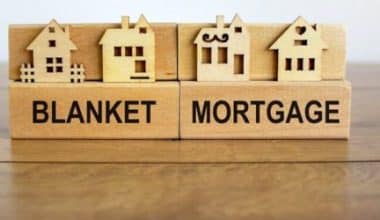A 30-year fixed-rate mortgage is a popular choice among homebuyers. However, there are times when your financial situation may not allow you to purchase a home, even if you really want to. The only way to complete a home purchase when a down payment is unavailable is to take out multiple loans. A piggyback mortgage may be an option to help you buy the home you want, but there are drawbacks to keep in mind before signing any paperwork.
Let’s go over these drawbacks and every detail of information you’d need to make the best decision regarding a piggyback mortgage.
Piggyback Mortgages are also known as Piggyback Loans
Overview
If you’re looking for a home but it’s out of your price range, particularly in hot markets, a piggyback loan can help with the upfront costs.
A piggyback loan is a second loan after the first mortgage to finance a single property. It is typically used to reduce initial mortgage costs, such as a down payment or private mortgage insurance, which many lenders require on the first mortgage.
Most lenders require a down payment of at least 20% of the home’s value. However, having that much cash on hand (without jeopardizing your savings) is not always possible, especially if home values are rapidly rising.
Some programs, such as Federal Housing Administration (FHA) or Veteran Affairs (VA) loans, allow borrowers to put down less money. Still, they come with certain requirements (income, location, etc.) that you must meet. Furthermore, you may be required to pay additional fees, making a piggyback loan a more appealing option.
Here’s what you need to know about piggyback loans for home loans.
History of Piggyback Loans or Mortgages
Many lenders offered home loans to those without the traditional 20% down payment in the early 2000s (pre-housing crisis). According to New York University’s Furman Center for Real Estate and Urban Policy, a quarter of all borrowers used a piggyback loan in 2006.
This meant that borrowers used two home loans to cover the cost of the home, one for 80% and another for the 20% down payment. When the housing bubble burst, many homeowners were left with negative equity, also known as being underwater (or upside down on their loans).
As a result, many people defaulted on their mortgages, and having two mortgages made it difficult to get a loan modification or short sale approval.
Piggyback loans have been limited to 90% loan-to-value since the housing recovery. This means that you must make a 10% down payment rather than the 80-20 loan that was popular during the bubble.
How a Piggyback Mortgage Works
A piggyback mortgage works: You obtain a mortgage for 80% of the home’s purchase price. Instead of paying the remaining 20% in cash, you take out a second loan (typically at 10%) and then put the remaining 10% down with cash.
Assume you want to buy a $200,000 home but only have $20,000 in savings. You would obtain a $160,000 (80%) mortgage using the piggyback loan strategy. Then you’d take out a piggyback loan for an additional $20,000 (10%). Finally, you would pay the remaining $20,000 (10%) down.
You use this strategy to obtain both loans at the same time. The second smaller loan, typically a home equity loan or line of credit (HELOC) with a 10-year draw period, supplements the first to meet your total borrowing needs.
However, you are not required to obtain loans from the same lender. If you notify your primary mortgage lender that you intend to use a piggyback loan, they will refer you to a second lender who can provide the additional financing.
Types of Piggyback Loan
The scenario described above is the most common piggyback loan structure, but it is not the only way to divide the funds. Here’s a closer look at the three most popular alternatives.
80/10/10
Piggyback loans are also known as 80/10/10 loans because that is the most common way to split the funds percentage-wise. The first number represents the primary mortgage amount (80%), while the second number represents the amount of the piggyback loan (10%). The final number represents the down payment (10%).
80/15/5
This is similar to an 80-10-10 loan, but you may prefer it if you have less than 10% for a down payment.
75/15/10
Another popular way to divide a piggyback loan is 75/15/10. This means that the first mortgage accounts for 75% of the purchase price, the secondary loan accounts for 15%, and the down payment is 10%. This version is frequently used when financing a condo because mortgage rates are higher when the loan-to-value (LTV) exceeds 75%.
Using the same $200,000 example from above, a 75/15/10 piggyback loan would look like this:
- Primary loan: $150,000 (75%).
- Secondary loan: $30,000 (15%)
- Down Payment: $20,000 (10%)
Why It Might Be Difficult to Get a Piggyback Loan
In theory, a piggyback loan appears to be the better option, but there are risks, so the lender will require proof that you can handle the additional debt.
One thing to keep in mind is that the mortgage lender will consider your debt-to-income (DTI) ratio when approving your loan. Because you’re essentially taking out two loans for a home, you’re incurring more debt, so you’ll need a higher income to cover both.
Your DTI should not exceed 28%, meaning the total monthly cost of both loans cannot exceed 28% of your gross monthly income. If your monthly pre-tax income is $6,000, for example, you will not be eligible for a piggyback loan that costs more than $1,680 per month.
Furthermore, because taking on two separate loans simultaneously is risky, you’ll need good credit to qualify for a piggyback loan. Each lender has different requirements, but a credit score of at least 680 is required.
The Benefits and Drawbacks of Piggyback Loans
You should or should not take out a piggyback loan for several reasons.
Benefits of Piggyback Loans
#1. Avoiding PMI
One of the most common reasons for obtaining a piggyback loan is to avoid paying private mortgage insurance (PMI), which protects the lender in the event of a default. Getting two mortgages is less expensive for the homeowner, and the interest is usually tax deductible. Before making such a significant financial decision, we recommend consulting with your tax advisor.
When you have 20% or more equity in your home, you have the legal right to request that your lender discontinue your PMI. Otherwise, the lender must discontinue PMI once you have achieved 22% equity in your home.
#2. Reduced Down Payments
A piggyback mortgage can also be used to finance more than 80% of the purchase price of a home (also known as 80% loan-to-value or LTV).
For example, if a home buyer only has enough money for a 5% down payment, they can get an 80/15/5 loan. The “80” refers to the first mortgage, which covers the first 80% of the home’s purchase price. The “15” refers to the second mortgage, which covers the remaining 15% of the purchase price. The “5” represents the 5% down payment made by the borrower.
This can be done in two ways: 80/15/5 or 80/10/10. Some lenders, however, offer an 80/20 option in which the second mortgage covers the remainder of the purchase price with no down payment.
#3. Convenience
A piggyback loan can be a useful tool for home buyers. You don’t have to go to two closings, sign two sets of paperwork, or pay two different closing costs because a piggyback mortgage closes at the same time as the first mortgage. If your primary lender does not offer piggyback loans, they will most likely recommend another lender with whom they have a working relationship.
The second loan can sometimes be structured so the homeowner can benefit from it. For example, if the second loan is a home equity line of credit, the homeowner can use the funds to make home improvements.
Piggyback loans can also be structured to accept only interest payments. This means you only have to pay the interest for a set period, but you can add as much principal as you want.
This option gives homeowners more options for how they can spend their money. They could put it into their 401(k) or other financial investments, pay off high-interest credit card debt, or put it away for a rainy day.
#4. Avoiding Jumbo Loan Interest Rates
If you’re looking for a more expensive home, a piggyback loan may allow you to avoid the lending limits of jumbo loans. Lower interest rates on the first mortgage will benefit you.
The Drawbacks of Piggyback Loans
On the other hand, piggyback mortgages have several disadvantages that can turn off a borrower. Here are a few examples:
#1. Higher interest rates
Because the second mortgage is tied to short-term interest rates, it is typically financed at a higher rate than the primary mortgage. These rates may eventually outweigh the cost of PMI.
#2. Higher monthly payments
Second mortgages are typically restricted to primary residences and have a shorter loan term than first mortgages. This means higher monthly mortgage payments and restrictions on the type of residence.
#3. Amount restrictions
Second mortgages are also restricted to loan amounts of no more than $100,000. Some lenders, however, allow for more.
Piggyback Mortgage Alternatives
#1. Pay for Private Mortgage Insurance
You may prefer to pay for PMI, especially if PMI is less expensive per month than a second mortgage payment. Lenders are required to cancel PMI once you have 22% equity in their home, but you can request that it be canceled sooner if they have 20% equity.
#2. Apply for a Jumbo Mortgage
If your credit score and debt-to-income ratio are high enough to qualify for a jumbo loan, you may prefer to make a single monthly payment.
#3. Purchase a Less Expensive Home
Buying a less expensive home may allow you to qualify for a conforming loan rather than a jumbo loan. This would eliminate your need for a piggyback loan to avoid a jumbo mortgage.
A more affordable home may allow you to afford a 20% down payment, removing the need for PMI.
#4. Get a Bridge Loan
Are you considering a piggyback loan because you’re relocating but haven’t yet sold your home? A bridge loan may be a better option.
This short-term home loan bridges the gap between when you buy your new home and when the proceeds from the sale of your previous home arrive. You can typically borrow up to 80% of the original home’s value, with terms ranging from six months to one year. If you want a shorter-term second loan so you don’t have to make two mortgage payments for a long time, you might prefer a bridge loan.
Your financial situation and the cost of housing in your area will most likely influence your decision between a piggyback loan and other options.
Other Possibilities
- Government-backed loan: Some loans backed by the federal government allow homebuyers to put down less money. FHA loans, for example, require as little as 3.5% down, though mortgage insurance is required. If you meet certain criteria, VA and USDA loans do not require a down payment.
- Down payment assistance programs: If you’re a first-time homebuyer, you may be eligible for special programs or grants that help you save money for a down payment. In most cases, you would not have to worry about paying PMI or having enough savings.
Conclusion
Before you take out two mortgages, do the math to ensure you’re saving money. While avoiding PMI may appear appealing, you may end up paying more for the loans than you would with mortgage insurance. Waiting until you have enough down payment to avoid two loans or PMI is the best way to save money throughout your home loan. If that isn’t an option for you, we have other options for buying a home with a low down payment.
Related Articles
- 80-10-10 Loan: Everything You Should Know!!!
- How To Avoid PMI (Private Mortgage Insurance): Detailed Guide
- PIGGYBACK LOAN: Definition, Pros, Cons & Refinancing Options
- WHAT IS A JUMBO MORTGAGE? Rates and Limits In 2023






